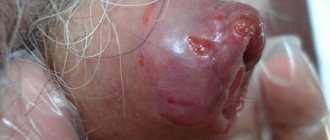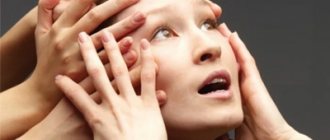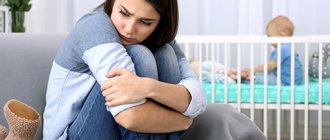Causes and provoking factors
The main cause of emotional problems is considered to be organic damage to brain structures.
And:
- heredity - if one of a person’s close blood relatives suffered from behavioral disorders, the risk of similar problems increases by 50%;
- history of infectious brain damage (encephalitis, meningitis);
- previous head injuries;
- bad habits;
- endocrine diseases, for example, diabetes;
- a difficult childhood caused by traumatic situations provoked by relatives;
- prolonged stress;
- experienced violence.
If there are several factors influencing at the same time, this significantly increases the likelihood of developing emotional problems.
Characteristic
Emotional problems have several key characteristics. Every person who has such mental disorders experiences negative emotions, manifested by apathy, depression, causeless nervous excitability and even suicidal thoughts. Hostility toward others is another core characteristic of emotional problems. A person does not adequately assess risks, and this is explained by his impulsiveness and inability to objectively assess the world around him. With a prolonged disorder, suicidal thoughts and auto-aggression arise - self-mutilation.
Signs include:
- development in adulthood;
- a person cannot control his behavior either alone or in society;
- inappropriate behavior leads to serious problems in relationships with relatives, colleagues, superiors and other people from the environment.
Emotional disorder syndromes
These syndromes include depressive and manic, which are characterized by a triad consisting of mood disorders, motor disorders and changes in the course of associative processes. However, this triad does not exhaust the clinical picture of both depressive and manic states. Characterized by disturbances in attention, sleep, and appetite. Autonomic disorders are most typical of emotional endogenous disorders and are characterized by signs of increased sympathetic tone of the autonomic nervous system, which are more pronounced in depression, but also occur in manic syndromes.
Depressive syndrome
Typical depressive syndrome. Depressive syndrome is characterized by a depressive triad: hypothymia, depressed, sad, melancholy mood, slow thinking and motor retardation. The severity of these disorders varies. Range of hypothymic disorders
great - from mild depression, sadness, depression to deep melancholy, in which patients experience heaviness, chest pain, hopelessness, worthlessness of existence. Everything is perceived in gloomy colors - the present, the future and the past. Melancholy in some cases is perceived not only as mental pain, but also as a painful physical sensation in the region of the heart, in the chest “precordial melancholy.”
Slowdown in the associative process
manifests itself in the impoverishment of thinking, there are few thoughts, they flow slowly, chained to unpleasant events: illness, ideas of self-blame. No pleasant events can change the direction of these thoughts. The answers to questions in such patients are monosyllabic; there are often long pauses between question and answer.
Motor retardation
manifests itself in slower movements and speech, speech is quiet, slow, mournful facial expressions, movements are slow, monotonous, patients can remain in one position for a long time. In some cases, motor retardation reaches complete immobility (depressive stupor).
Motor retardation in depression can
play a sort of protective role. Depressed patients, experiencing a painful, painful state, hopeless melancholy, hopelessness of existence, express suicidal thoughts. With severe motor retardation, patients often say that it is so hard for them that it is impossible to live, but they do not have the strength to do anything, to kill themselves: “If only someone would come and kill them, that would be wonderful.”
Sometimes motor retardation is suddenly replaced by an attack of excitement, an explosion of melancholy (melancholic raptus - raptus melancholicus). The patient suddenly jumps up, hits his head against the wall, scratches his face, can tear out an eye, tear his mouth, injure himself, break glass with his head, jump out of the window, while the patient screams and howls heart-rendingly. If the patient can be restrained, the attack weakens and motor retardation sets in again.
With depression, daily fluctuations are often observed; they are most characteristic of endogenous depression. In the early morning hours, patients experience a state of hopelessness, deep melancholy, and despair. It is during these hours that patients are especially dangerous for themselves; suicides are often committed at this time.
Depressive syndrome is characterized by ideas of self-blame, sinfulness, and guilt, which can also lead to thoughts of suicide.
Instead of experiencing melancholy, depression may result in a state of “emotional insensitivity.” Patients say that they have lost the ability to worry, have lost feelings: “My children come, but I don’t feel anything for them, it’s worse than melancholy, melancholy is human, but I’m like wood, like stone.” This condition is called painful mental insensibility (anaesthesia psychica dolorosa), and depression is anesthetic.
Depressive syndrome is usually accompanied by severe vegetative-somatic disorders: tachycardia, discomfort in the heart, fluctuations in blood pressure with a tendency to hypertension, gastrointestinal disorders, loss of appetite, weight loss, endocrine disorders. In some cases, these somatovegetative disorders can be so pronounced that they mask the actual affective disorders.
Depending on the predominance of various components in the structure of depression, melancholy, anxious, apathetic depression and other variants of the depressive state are distinguished.
In the affective link of the depressive triad, O. P. Vertogradova and V. M. Voloshin (1983) distinguish three main components: melancholy, anxiety and apathy. Disturbances in the deatorial and motor components of the depressive triad are represented by two types of disorders: inhibition and disinhibition.
Depending on the correspondence of the nature and severity of ideation and motor disorders to the dominant affect, harmonious, disharmonious and dissociated variants of the depressive triad are distinguished, which have diagnostic significance, especially in the initial stages of the development of depression.
Ideas of self-blame in depressive syndrome sometimes reach the level of delusion. Patients are convinced that they are criminals, that their entire past life is sinful, that they have always made mistakes and unworthy actions and now they will face retribution.
Anxious depression. It is characterized by a painful, painful expectation of an inevitable concrete misfortune, accompanied by monotonous speech and motor agitation. Patients are convinced that something irreparable is about to happen, for which they may be to blame. Patients cannot find a place for themselves, walk around the department, constantly turn to the staff with questions, cling to passersby, ask for help, death, and beg to be let out into the street. In some cases, motor excitement reaches a frenzy, patients rush about, groan, moan, lament, shout out individual words, and can cause harm to themselves. This condition is called “agitated depression.”
Apathetic depression. Apathetic, or adynamic, depression is characterized by a weakening of all impulses. Patients in this state are lethargic, indifferent to their surroundings, indifferent to their condition and the situation of loved ones, reluctant to make contact, do not express any specific complaints, and often say that their only desire is not to be touched.
Masked depression. Masked depression (lavaged, depression without depression) is characterized by a predominance of various motor, sensory or
autonomic disorders of the type of depressive equivalents. The clinical manifestations of this depression are extremely varied. Various complaints of disorders of the cardiovascular system and digestive organs are common. There are attacks of pain in the heart, stomach, intestines, radiating to other parts of the body. These disorders are often accompanied by sleep and appetite disturbances. Depressive disorders themselves are not clear enough and are masked by somatic complaints. There is a point of view that depressive equivalents are the initial stage in the development of depression. This position is confirmed by observations of subsequent typical depressive attacks in patients with previously masked depression.
With masked depression: 1) the patient is treated for a long time, persistently and to no avail by doctors of various specialties; 2) when using various research methods, a specific somatic disease is not detected; 3) despite failures in treatment, patients stubbornly continue to visit doctors (G.V. Morozov).
Depressive equivalents. Depressive equivalents are usually understood as periodically occurring conditions characterized by various complaints and symptoms of a predominantly vegetative nature, replacing attacks of depression in manic-depressive psychosis.
8.4.1.1. Comparative age characteristics of depressive syndrome
In preschool children, depression manifests itself in autonomic and motor disorders, since these forms of response are characteristic of this age.
At an earlier age, depression feels even less like depression. Children are lethargic, restless, their appetite is impaired, they experience weight loss and sleep disturbances.
Depressive states can occur when the child is emotionally depressed or deprived of contact with his mother. For example, when a child is placed in a medical institution, he first develops a state of motor excitement with crying, despair, then lethargy, apathy, refusal to eat and play, and a tendency to somatic symptoms appear.
BY
diseases. Such conditions are more often referred to as “analytical depression.”
Analytical depression occurs in children aged 6-12 months, separated from their mother and in poor living conditions, and is manifested by adynamia, anorexia, a decrease or disappearance of reactions to external stimuli, and delayed development of the psyche and motor skills.
In young children, adynamic and anxious depression are distinguished. Adynamic depression is manifested by lethargy, sluggishness, monotony, joyless mood, anxious depression - by tearfulness, capriciousness, negativism, motor restlessness (V. M. Bashina).
In preschool age, autonomic and motor disorders predominate, but the appearance of children indicates a low mood: a pained expression on their face, posture, and quiet voice. At this age, daily fluctuations in well-being are noted, and hypochondriacal complaints of unpleasant sensations in various parts of the body appear. There are several types of depression depending on the prevailing disorders.
In children of primary school age, behavioral disorders come to the fore: lethargy, isolation, loss of interest in games, difficulties in mastering school material. Some children experience irritability, touchiness, a tendency to aggression, and absenteeism from school. Complaints of melancholy in children cannot be identified. “Psychosomatic equivalents” may be observed - enuresis, loss of appetite, weight loss, constipation.
At puberty, a depressive effect is already detected, which is combined with severe autonomic disorders, headaches, sleep disturbances, appetite, constipation, and persistent hypochondriacal complaints. In boys, irritability often predominates, in girls - depression, tearfulness and lethargy.
At puberty, the clinical picture of depression approaches depressive states in adults, but ideational (associative) inhibition is less distinct. Patients quite actively express ideas of self-blame and hypochondriacal complaints.
Features of depressive syndromes in late age are associated with changes in human mental activity and are determined by the biological processes of age-related involution. Late-life depression is characterized by its
figurative “reduction and reduction” of disorders, absence of depressive self-esteem and depressive reassessment of the past (the past is more often perceived as prosperous and happy), the predominance of fears for health, fear of financial difficulties. This reflects the age-related “revaluation of values” (E. Ya. Sternberg).
At a later age, depression is classified as simple with lethargy and anxiety. Simple depressions are less common with age, and the number of anxious-hypochondriacal and anxious-delusional states increases. The greatest number of depressive states with anxiety occurs at the age of 60-69 years.
With all types of depressive conditions, sleep disturbances, appetite disturbances, changes in body weight, constipation, etc. are observed.
Often patients with depression in late life experience a “feeling of being changed,” but in older people the complaints usually concern somatic changes.
Signs of mental anesthesia are more often observed in people who become ill before 50 years of age, compared to patients of a later age.
Severe motor retardation is not typical for depressive states of late age; depressive stuporous states almost never occur. Anxiety-agitated depression is observed both in involutionary and late age.
In patients of late age, hypochondriacal disorders occupy a large place in the clinical picture of depression, but more often than hypochondriacal delusions (Cotard's syndrome), there are anxious fears of hypochondriacal content or fixation on various somatic complaints.
Manic syndrome
Manic syndrome is characterized by a manic triad: hyperthymia
- elevated, joyful mood,
acceleration of associative processes
and
motor excitement with
The severity of these disorders varies: acceleration of associative activity can range from a slight facilitation of associative activity to a “jump of ideas”; promotion
activity may reach disordered excitement (confused mania). The mood is not only joyful and cheerful, but in some cases an angry affect predominates (angry mania).
Manic syndrome is characterized by distractibility, and therefore patients cannot complete the work they have started, or consistently report their anamnestic information.
intelligence. Despite the fact that the patient talks incessantly and willingly talks with the doctor, this conversation is unproductive, since the patient is distracted by various external events or associations that arise in him. These associations are usually superficial.
Patients in a manic state usually do not present somatic complaints; they experience not only “emotional elation,” but also a surge of physical strength. In this condition, patients tend to overestimate their abilities and capabilities. Women, despite their advanced age, are convinced of their irresistible attractiveness and claim that all students and doctors are in love with them. Patients tend to decorate their clothes, use cosmetics excessively, and do intricate hairstyles. Patients in a manic state exhibit the ability to write poetry, draw, sing, and compose music. Typically, the less pronounced the manic state, the more productive this activity is.
The possibilities for implementing numerous plans seem unlimited to such patients; they do not notice any obstacles. Increased self-esteem. Patients are convinced that great discoveries await them, that they can play a role in solving serious social problems. Such an overestimation of capabilities can reach the level of expansive delirium.
Patients experience speech agitation, they speak a lot, quickly, loudly. With pronounced speech arousal, after a few days the voice becomes hoarse. In some cases, patients cannot fully express a thought; due to severe distractibility, they do not finish sentences or shout out only individual words. The patients themselves say that their tongue cannot keep up with their thoughts.
With less pronounced speech excitation, acceleration of associative activity is detected when writing; patients do not complete phrases or write only individual words.
""M iinshahl larashsrsn. UilH ANIMATED, FACE
often hyperemic, lively facial expressions, fast movements, cannot sit still, grabs onto various things, but cannot complete any of them. The appetite is often increased, they eat greedily, and quickly swallow poorly chewed food.
Sexual desire is increased, patients easily enter into contacts, have sexual relationships, get married, and make unreasonable promises.
Manic syndrome in manic-depressive psychosis is usually not accompanied by the emergence of true delusional ideas of grandeur, although patients overestimate their capabilities and their role in a past life. These statements, as a rule, do not reach the level of delirium, have the character of overvalued ideas of greatness and are not distinguished by their persistence.
There are several variants of manic syndrome: cheerful mania,
most characteristic of manic-depressive psychosis,
unproductive mania,
in which elevated mood and motor agitation are not accompanied by a desire for activity,
mania with foolishness,
in which elevated mood with motor and speech excitation is accompanied by mannerisms, childishness, and a tendency to make ridiculous jokes.
Mopi is characterized by a combination of an uplift in mood with disinhibited desire, foolishness, flat, ridiculous jokes, and sometimes there is an obstruction of consciousness. They are most often observed with damage to the frontal lobes.
Mild variants of manic states are usually called hypomania.
8.4.2.1. Comparative age characteristics of manic syndrome
The presence of manic states in young children is not recognized by everyone. Its signs include disinhibition of drives and instability of mood.
In children of preschool and primary school age, one can think of a hypomanic state only in cases where an elevated mood with euphoria and severe behavioral disturbances continues for a long time. At this age, hypomania can manifest itself in motor disinhibition, fussiness, disobedience, stubbornness, and verbosity.
In a manic state, the euphoric mood is quite distinct, but behavioral disturbances remain the leading ones. Patients are motor-active, aggressive, pugnacious, sexually disinhibited, and gluttonous.
In older adolescents, manic states are similar to the same disorders observed in adults.
In old age, manic syndrome is characterized by monotony, monotony, euphoric affect with carelessness predominates over a cheerful, high mood. Against the background of elevated mood, faint-hearted reactions may occur.
Elderly patients in a manic state are usually unproductive, the range of associations is relatively poor, and there is often a thoroughness and a tendency to detail.
Instead of liveliness and wit, there is a tendency to flat jokes, superficial judgments, and making ridiculous plans. Instead of a desire for activity, there is aimless fussiness, which intensifies in the evening and at night.
Patients are often sloppy, do not take care of their clothes, their hair is disheveled, their pockets are filled with garbage and food scraps.
At this age, there is often a discrepancy between low mobility and speech arousal.
Chapter 9
VOLITIONAL DISORDERS
Will is a person’s conscious, purposeful control of his activities. Volitional activity is inherent only to humans. Animal behavior is determined by instincts and conditioned reflex connections. In the process of socio-historical development, humans have developed forms of adaptation to the environment based on differentiated conditioned reflex reactions and voluntary control of instincts.
The following stages are distinguished in the volitional process: 1) motivation, awareness of the goal and the desire to achieve it; 2) awareness of a number of possibilities for achieving the goal; 3) struggle of motives and choice; 4) making one of the possible decisions; 5) implementation of the decision made.
The totality of desires, motives, aspirations,
sti. The motivations for activity, motives and goals of implementation are distorted in connection with the psychopathological symptoms the patient has: for example, auditory hallucinations of a frightening nature encourage aggressive activity, etc.
9.2. Drive disorders
9.2.1. Perversion of instinctual drives
Instincts play a significant role in a person’s life; with age they are subject to the control of volitional activity. Violations of instinctive reactions are more often observed in children and adolescents. Usually there are disorders of the desire for food, the instinct of self-preservation, and disorders of sexual desires.
Disorders of cravings for food. Increased craving for food - bulimia
(from the Greek bus - bull + limos - hunger, wolf hunger, kinorexia) - a pathological, sharply increased feeling of hunger, often accompanied by general weakness and abdominal pain. It is observed in hyperinsulinism and mental illness, in mental retardation, and defective states in schizophrenia.
At a certain stage of anorexia nervosa, against the background of refusal to eat, an irresistible craving for food appears, accompanied by eating huge quantities of it and then inducing vomiting. Bulimia occurs in certain states of emotional stress, when eating large quantities of food relieves it.
Anorexia
(an - a particle meaning the absence of a characteristic or quality, + Greek ogeh - desire to eat, appetite) - loss of the feeling of hunger, lack of appetite in the presence of a physiological need for nutrition.
At puberty, with anorexia nervosa, at first, refusal to eat occurs for the purpose of losing weight, then the feeling of hunger fades and even an aversion to food appears.
Loss of the feeling of hunger is observed in mental illnesses: depression, catatonic stupor, severe alcohol withdrawal. Anorexia with significant weight loss is observed in Simmonds and Sheehan syndromes.
Polydipsia
(from the Greek polys - many, dipsa - thirst) - increased fluid consumption, indomitable thirst, most often found in endocrine diseases, but cases of psychogenic polydipsia have been described.
acquiring the character of motivational activity, constitutes the motivational sphere. The motivational sphere includes both conscious (volitional) and insufficiently conscious actions based on various motives (drives, attitudes, etc.).
Volitional disorders can relate both to the level of motivation for activity and awareness of the goal, i.e., the formation of a motive, the adequacy of motives to the properties of the individual and the situation, and decision-making, appropriate behavior at all stages of the volitional process.
9.1. Symptoms of volitional disorders 9.1.1. Violations of volitional impulses
Abulia
(from the Greek bule - will), or
dysbulia
- a pathological lack of desires and motivations for activity. Abulia is usually followed by adynamia (Greek adinamie - impotence) - a decrease or complete cessation of motor activity of the body or organ.
Abulia is observed in various pathological processes, primarily in schizophrenia, in various frontal lesions and in depression.
A decrease in volitional activity can lead to the release of lower actions - automated and instinctive.
Hypobulia
- decreased volitional activity, poverty of motives, inactivity, lethargy, decreased motor activity, lack of desire to communicate. These features are often observed in depressive states and schizophrenia. Weakening of attention, impoverishment of thinking, slowing of speech can be observed in states of deafness.
Hyperbulia
- increased activity due to a significant number of motivations for activity, often changing in order to implement them. Hyperbulia is observed in manic states and paranoid syndrome.
In a manic state, productivity is usually low due to the rapid distractibility of patients and rapid changes in motives. In paranoid syndrome, the activity is one-sided, caused by delusional motives.
Parabulia
- perversion, change in volitional activity
Parorexia,
or
pica
(from the Latin pica - magpie), a perversion of appetite that extends to inedible substances.
Coprophagia
(from the Greek kopros - feces, phagos - devouring), or
scatophagy
(Greek syn.), - the desire to eat one's own excrement.
Violations of the self-preservation instinct. These disorders can manifest themselves as exacerbation of defensive reactions, increased alertness and readiness for panic reactions, fears when exposed to various stimuli, especially painful ones.
Weakening the self-preservation reflex
- disappearance of the reaction when a real danger arises, during painful stimulation, perversion of the defensive reflex in mental illness is manifested in self-harm and suicidal behavior.
Sexual desire disorders see Chapter 33.
9.2.2. Impulsive drives and impulsive actions
Impulsive drives are irresistible drives to achieve goals that are inadequate to the real situation, carried out without resistance or struggle, but with subsequent critical assessment.
Impulsive action - a sudden, rapid, unmotivated action that lasts seconds or minutes; a sign of severe mental disorder.
Dromomania
(poriomania) - impulsive desire to change places. Dromamania is usually understood as an attraction to running away from home, wandering and changing places; it is observed in various mental illnesses. In the formation of dromomania, a reactive stage is distinguished - the first leaving home due to mental trauma, then leaving becomes habitual, fixed, and to any minor unfavorable situation a habitual reaction arises - leaving home.
Subsequently, leaving home becomes motiveless, unexpected, and acquires the character of impulsiveness.
1 Suicidal behavior is a set of actions carried out by an individual aimed at committing a suicide attempt.
Dromomania is most characteristic of childhood and adolescence, but there are cases when, having arisen in childhood, dromomania persists in adult men and women, and the woman is not stopped by the presence of small children, whose health is endangered during vagrancy.
Dipsomania
- an irresistible attraction to drunkenness, accompanied by severe alcoholic excesses. The attraction to alcohol can be so strong that, despite a critical attitude towards it, at first it is not possible to overcome the attraction. In this state, patients commit all sorts of unseemly acts: deception, theft, aggression in order to get the desired alcohol. In some cases, it is possible to identify a change in mood that precedes an attack of dipsomania.
Pyromania
- an attraction to arson, irresistible, unmotivated, suddenly arising, but not accompanied by a change in consciousness.
Kleptomania
(from the Greek klepto - steal + mania), or impulsive theft, unmotivated attraction to theft.
Coprolalia
(from Greek kopros - feces + lalia - speech) - impulsive utterance of swear words and obscene language. This symptom can be observed in Gilles de la Tourette's disease.
Mythomania
- an irresistible attraction to lies and deception. Sometimes this is observed in hysterical individuals to attract attention.
What are emotional disorders?
Emotional problems from the point of view of psychiatry are a person’s inadequate perception of others and situations occurring in his life. The patient cannot control the intensity of the expression of emotions, which is why behavior is assessed by others as inadequate and strange.
Emotional disorders are conventionally divided into 2 groups:
- Emotional disorders.
- Problems with the adequacy of emerging emotions.
Disorders of emotional perception include:
- affect – uncontrollable emotions that interfere with a sober assessment of the environment;
- hyperthymia - causeless joy, accompanied by overly pronounced facial expressions;
- euphoria – occurs due to the use of alcohol, drugs and is manifested by nervous agitation;
- hypotomia - manifested by loss of strength, depression, negative assessment of the environment;
- apathy – lack of interest in something, ignoring problems;
- anger – nervous excitement that develops into uncontrollable aggression;
- lack of emotions - emotional coldness and alienation, provoking severe stress;
- phobias – obsessive fear of something;
- obsession - the desire to perform some action at any cost;
- ambivalence – simultaneous experience of opposite states (apathy + obsession, hyperthymia + hypotomia).
- Violations of the adequacy of emotions are manifested by the following disorders:
- dysphoria – intense anger that occurs in response to a minor stimulus;
- amymia – absence of facial expressions (“stony” face);
- paramimia - facial expressions that do not correspond to the experienced feelings;
- hypermia is rapidly changing facial expressions.
Classification
Emotional disorders can be independent disorders or components of other mental illnesses. Pathological intensification of emotions is manifested by an increase in their intensity while maintaining adequate content. This group of disorders includes:
- Depression.
The structure of depressive states is dominated by low mood and depression. Patients feel anxiety and a feeling of inferiority. They perceive everyday difficulties as insurmountable and provoke crying, despondency, and reluctance to do anything. - Mania.
Manic states are manifested by elevated mood, accelerated rate of mental activity, and increased physical activity. A person becomes hyperactive, fussy, strives for achievements, to learn new things, but he lacks concentration and focus. - Euphoria.
In euphoria, people are dominated by carelessness, elevated mood, and infantility. Critical abilities and serious attitude to situations decrease. Passivity and excessive complacency do not allow you to perform daily duties.
Another option for psycho-emotional disorders is weakening of emotions. Regardless of the events taking place - joyful, sad, provoking aggression - people remain indifferent or experience weak feelings that do not correspond to the significance of the situation. Examples of such disorders:
- Emotional flattening.
With some mental illnesses, for example, with schizophrenia, emotions become impoverished - they become monotonous, primitive, and weakly expressed. In severe cases, only some manifestation of dissatisfaction in situations of discomfort remains. Other events - meetings with relatives, the loss of a loved one - do not evoke any emotions. - Apathy.
A state of apathy is typical for patients with depression. There is a general decrease in all emotional reactions. The patient is indifferent to what is happening, unable to experience joy, sadness, fear, anger. Often apathy is combined with a decrease in motor activity and abulia - pathological lack of will, the inability to begin any action.
When the mobility of emotions is impaired, a person’s ability to control the duration of the experience changes. This is manifested by stuckness, suddenness, or rapid uncontrollable changes in emotional states. There are several variants of the dynamic aspect disorder:
- Emotional lability.
With affective lability, emotions arise easily, quickly replace each other, and depend on fleeting external events or random memories. Such conditions are considered normal in early childhood, when a child’s tears suddenly give way to laughter, but in adults they are a sign of emotional disturbance. - Explosiveness.
This term refers to emotional explosiveness. After a period of calm, a person suddenly demonstrates anger, irritation, anger, and then just as quickly returns to a state of balance. During explosive outbreaks, aggression and provocation of conflicts are possible. - Inertia.
Synonyms for inertia are stuckness, stiffness. Such people experience one emotion for a long time, cannot be distracted and change it at will, and are in a state of irritability, melancholy, and anger.
The most striking psycho-emotional disorders are disturbances of adequacy. Inappropriate emotional manifestations are classified as pathological according to the content criterion: what a person feels has no connection with his thoughts or external events. This group includes:
- Inadequacy.
With emotional inadequacy, a person experiences and demonstrates emotions that are completely inappropriate for the situation. For example, laughter occurs in response to the news of the death of people, outbursts of anger when meeting a loved one (mother, friend). - Ambivalence.
People with schizophrenia often experience ambivalence of experiences - the simultaneous existence of opposing emotions. This condition is difficult for a healthy person to understand. Outwardly, it manifests itself as a constant, unconditional change of joy and melancholy, tenderness and anger, anger and tearful weakness. - Emotional tension.
Inappropriate experiences may include pointless fear, unmotivated anxiety, an inexplicable feeling of anger or dissatisfaction with oneself. In such conditions, people are in emotional tension, but cannot determine what is causing it. Usually they say: “the soul is restless”, “the soul suddenly sinks into the heels.”
Symptoms
Emotional problems are varied. But there are typical symptoms for them that create the clinical picture necessary to diagnose the patient. Thus, human behavior is controlled only by emotions, against the background of which the ability to objectively assess life situations is lost. All actions are taken under the influence of momentary desires. Changeable mood makes it impossible to make plans and keep promises to others. A minimal stimulus is enough to provoke uncontrolled aggression, nervous agitation and other behavioral disorders in the patient. A person often experiences suicidal and depressive thoughts, which indicates long-term emotional problems.
Against the background of symptoms of emotional disorders, the quality of life deteriorates. This is manifested by conflicts with others, the inability to conscientiously fulfill official duties.
Diagnostics
A psychiatrist diagnoses emotional problems. To make a diagnosis, a list of typical manifestations of pathology is taken into account:
- Inadequacy of emotions.
- Lack of self-control.
- Behavioral disorders affect all areas of life.
- There were problems with social adaptation.
- The patient had previously been diagnosed with organic brain lesions.
- The man has experienced psychological trauma.
If the disorders correspond to at least three points on the list above, the psychiatrist will diagnose emotional disorders and develop an individual treatment regimen.
Treatment
Treatment for emotional disorders includes:
- Taking medications is prescribed only by a doctor for organic brain damage and severe psycho-emotional abnormalities. The choice of medications depends on the specifics of the disorder. For apathy, depression and suicidal tendencies, antidepressants are prescribed. Taking tranquilizers is advisable for panic attacks, attacks of uncontrolled aggression, and obsessions. For increased excitability, antipsychotics are prescribed.
- Psychotherapy is the basic method of treatment. The correction program for psycho-emotional problems is developed individually, taking into account the causes of behavioral deviations, the patient’s condition and medical history.
The patient may be hospitalized in a hospital. The reasons for this decision include the statement of the patient’s relatives about the need for his hospitalization in a psychiatric clinic. Such a measure is provided if the patient’s behavior threatens the health and lives of others.
Consultations
Psychotherapist
Group psychotherapy
Psychologist
Family psychotherapy
Diagnosis of disorders
At the Leto mental health center, a study is carried out with the participation of several specialists to more accurately identify the main cause of deviations.
Doctors use:
- Detailed survey.
- Inspection.
- Psychodiagnostic tests.
- Observation.
- Use of information provided by the patient's relatives.
Forecast
The most favorable prognosis is for patients whose emotional disorders are not associated with brain damage and severe dependence on alcohol and drugs. The sooner professional assistance is provided to the patient, the better the prognosis. With neurological diseases, it will not be possible to achieve a complete cure. However, proper treatment, support from loved ones and the creation of a favorable psychological climate will significantly improve the patient’s psycho-emotional state and quality of life.
Treatment of patients suffering from emotionally unstable personality disorders
In order to correctly select adequate therapy, it is necessary to identify the cause causing the disturbance of emotions. In mild cases, outpatient counseling and therapy in a day hospital are sufficient. In moderate to severe situations, hospitalization is required.
In the hospital, when diagnosing the patient, the main diagnosis is established. On this basis, individual treatment is prescribed.
Depending on the causative pathology, the treatment plan includes:
Pharmacotherapy. The most commonly used medications are psychotropic drugs - antidepressants, tranquilizers, antipsychotics, and symptomatic drugs.- Psychotherapy. For almost any disease, this type of treatment has a positive effect.
- Medical and rehabilitation measures. Recommended for people with social dysfunction.
After completing the main course, follow-up monitoring of the patient is advisable. Therefore, psychiatrists at the Leto clinic insist on periodic consultations with treated people.










